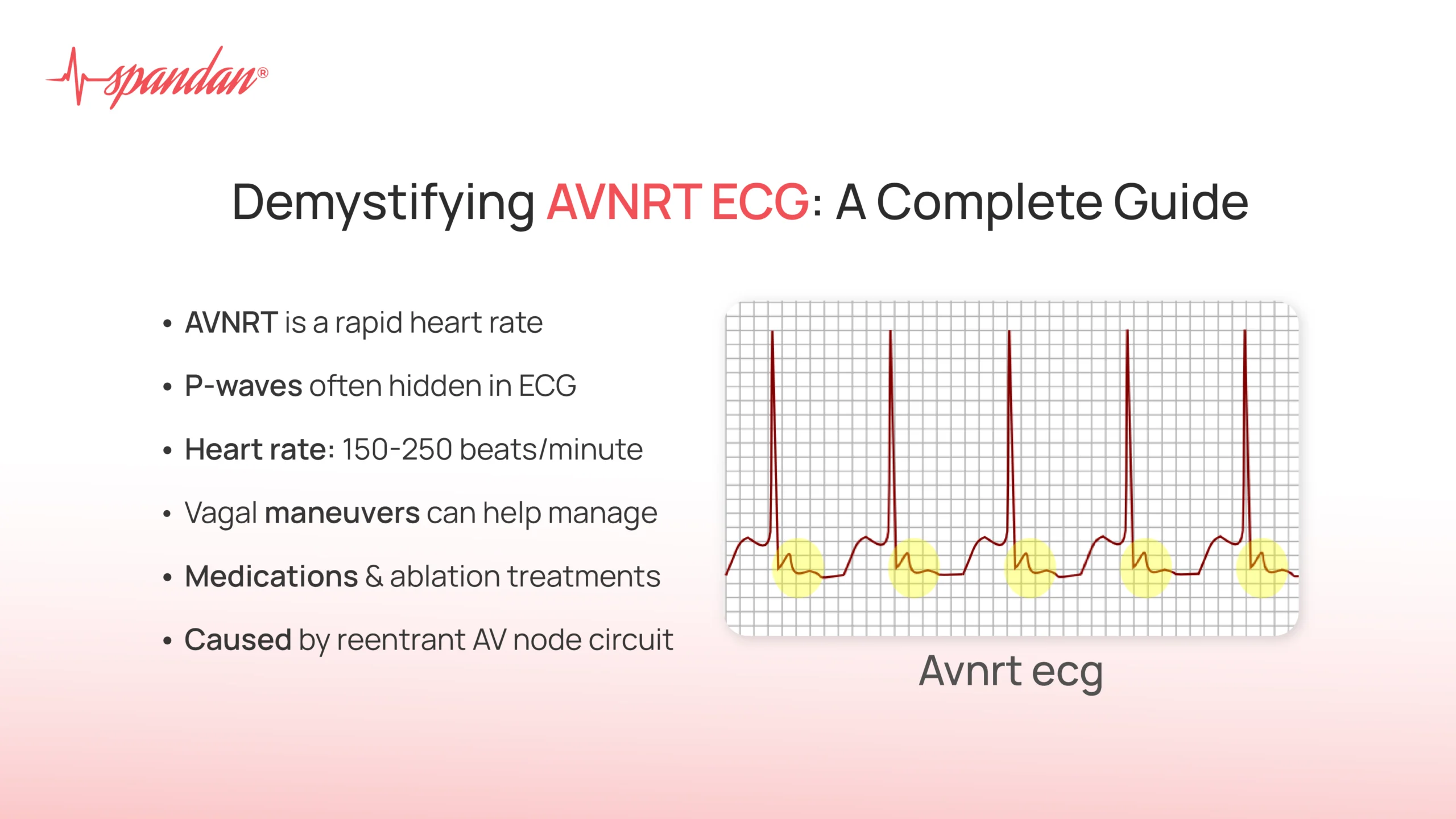
Related Article
Author:- Mr. Ritesh Sharma
Electrocardiograms (ECGs) are indispensable tools in modern cardiology, allowing healthcare professionals to capture and analyze the heart’s electrical activity in real-time. Among the myriad arrhythmias that can be diagnosed using an ECG, Atrioventricular Nodal Reentrant Tachycardia (AVNRT ECG) is a notably prevalent condition. This arrhythmia is characterized by a rapid heart rate originating from a reentrant circuit within or near the atrioventricular (AV) node. AVNRT can cause a range of symptoms, including palpitations, dizziness, and sometimes even fainting, making accurate diagnosis and effective management crucial. The AVNRT ECG plays a central role in this process, providing detailed insights into the arrhythmia’s nature and guiding therapeutic interventions.
Understanding the AVNRT ECG requires a nuanced approach, as it involves recognizing specific patterns that are indicative of this arrhythmia. For instance, in many cases, the P-waves may be buried within the QRS complex or may appear after it, and the heart rate is typically elevated.
Deciphering these patterns can be challenging but is essential for correct diagnosis. This guide aims to demystify the AVNRT ECG by offering a detailed examination of its diagnostic features, types, and management strategies. By exploring the nuances of the AVNRT ECG, healthcare providers can enhance their diagnostic accuracy and provide more effective care for patients suffering from this often distressing condition.
What is AVNRT?
Atrioventricular Nodal Reentrant Tachycardia (AVNRT) is a type of supraventricular tachycardia that originates from a reentrant circuit within or around the atrioventricular (AV) node. This arrhythmia is characterized by a rapid heart rate, typically ranging from 150 to 250 beats per minute. AVNRT often presents with symptoms such as palpitations, dizziness, and occasionally syncope (fainting).
Recognizing AVNRT ECG
The AVNRT ECG provides crucial information for diagnosing this cardiac arrhythmia. Understanding how to interpret an AVNRT ECG is essential for accurate diagnosis and appropriate treatment. Here’s a step-by-step guide to recognizing AVNRT on an ECG:
- P-Wave Characteristics: In AVNRT, P-waves may be absent, buried in the QRS complex, or appear after the QRS complex showcasing both P-wave ECG abnormalities and QRS complex abnormalities. The exact appearance of the P-wave can vary depending on the specific type of AVNRT. However, the key is to note the absence or unusual position of P-waves relative to the QRS complexes.
- QRS Complexes: Typically, the QRS complexes are narrow in AVNRT because the arrhythmia involves a reentrant circuit that does not involve the ventricular conduction system. However, if there is preexisting bundle branch block or other conduction issues, the QRS complexes might be wider.
- Heart Rate: The heart rate in AVNRT is generally rapid, ranging from 150 to 250 beats per minute. This elevated rate is a hallmark feature of AVNRT and helps differentiate it from other cardiac arrhythmias.
- Rhythm Regularity: AVNRT usually presents with a regular rhythm. The regularity of the QRS complexes and the absence of irregularities in the intervals can help confirm the diagnosis.
- Retrograde P-Waves: In some cases, retrograde P-waves may appear after the QRS complexes. These waves are a result of the reentrant circuit affecting the atria after passing through the AV node.
Types of AVNRT
Understanding the different types of AVNRT is crucial for accurate diagnosis and treatment:
- Typical AVNRT: The most common form, where the reentrant circuit involves the AV node and a surrounding area. This type usually shows P-waves that are hidden or appear after the QRS complex on the ECG.
- Atypical AVNRT: Less common and can involve additional pathways or structures around the AV node. Atypical AVNRT may present with more complex ECG patterns.
Diagnosis of AVNRT
The diagnosis of AVNRT involves a combination of clinical evaluation and ECG findings. Here’s a comprehensive approach to diagnosing AVNRT:
- Clinical History: A detailed patient history, including symptoms and their triggers, is essential. Palpitations, dizziness, and episodes of rapid heart rate are common indicators.
- ECG Analysis: Analyzing the ECG for the characteristics described above is crucial. A typical AVNRT ECG will show a rapid, regular heart rate with narrow QRS complexes and possible absence or abnormal position of P-waves.
- Electrophysiological Study: In some cases, an electrophysiological study may be required to confirm the diagnosis. This involves inserting catheters into the heart to study its electrical activity and identify the exact reentrant circuit.
Treatment and Management
Management of AVNRT focuses on controlling the symptoms and addressing the underlying arrhythmia. Here are common treatment options:
- Vagal Maneuvers: These are non-invasive techniques used to slow down the heart rate by stimulating the vagus nerve. Techniques such as the Valsalva maneuver or carotid sinus massage can sometimes terminate AVNRT episodes.
- Medications: Antiarrhythmic medications, such as adenosine or beta-blockers, can be used to manage AVNRT. These medications help in controlling the heart rate and preventing recurrence.
- Catheter Ablation: For patients with frequent or severe episodes, catheter ablation may be recommended. This procedure involves using radiofrequency energy to destroy the abnormal tissue causing the arrhythmia.
- Lifestyle Modifications: Identifying and avoiding triggers that may precipitate AVNRT episodes, such as caffeine or stress, can help in managing the condition.
Prognosis and Follow-Up
The prognosis for individuals with AVNRT is generally favorable with appropriate treatment. Most patients experience significant symptom relief with medication or ablation therapy. Regular follow-up with a cardiologist is essential to monitor the condition and adjust treatment as needed.
The AVNRT ECG is a powerful tool for diagnosing and managing atrioventricular nodal reentrant tachycardia. By understanding the characteristic features of AVNRT on an ECG, healthcare professionals can accurately diagnose this arrhythmia and provide effective treatment. Whether through non-invasive maneuvers, medication, or catheter ablation, the goal is to manage symptoms and improve the quality of life for individuals affected by AVNRT.
A thorough understanding of AVNRT ECG and its implications helps in delivering precise care and ensuring better outcomes for patients. As with all arrhythmias of different arrhythmia classifications, early detection and appropriate management are key to achieving optimal results.




